How to Use Real Estate Email Marketing to Close More Deals
Published on May 9, 2025
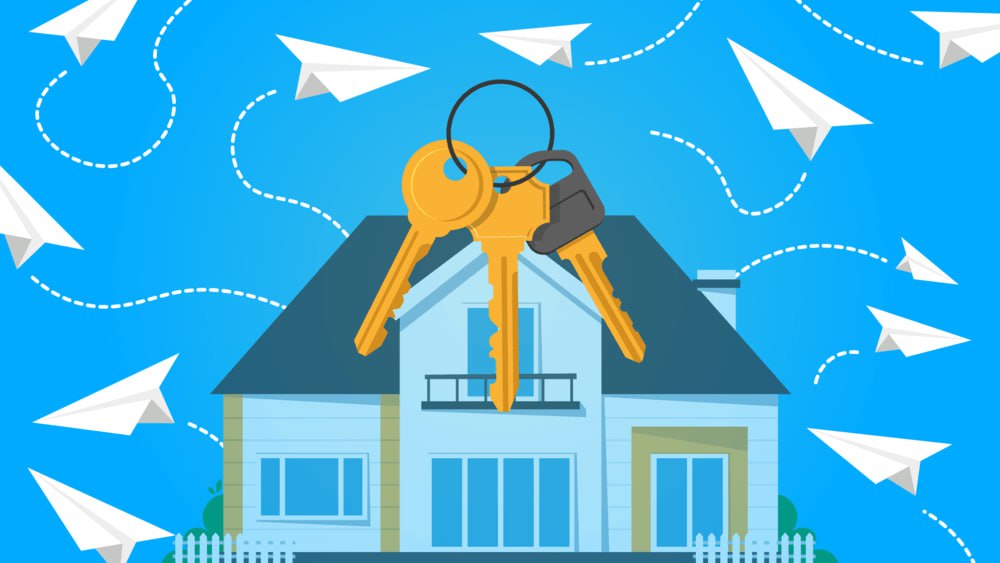
In a competitive and fluctuating real estate market influenced by inflation, interest rates, and remote work trends, staying top of mind with potential buyers and sellers is a key driver of business growth for brokers and agents.
Real estate brokerages need smarter ways to nurture leads, automate follow-ups, and close more deals — without burning out their team.
This is where email marketing outperforms other marketing channels.
It delivers top-tier ROI (an average conversion rate of 1.4%), lets you personalize touchpoints, and can run in the background while you focus on selling. And with home sales up 9.3% in 2024 — the biggest jump since mid-2021 — now’s the time to turn prospects into clients (and referral machines).
This real estate marketing email guide features 19 proven emails, plus clear, actionable strategies to build relationships and convert prospects into clients.
Feel free to skip ahead:
- 19 Real Estate Email Examples that Turn Leads into Loyal Clients
- 7 Steps to Implement Real Estate Email Marketing
19 Real Estate Email Examples that Turn Leads into Loyal Clients
Most real estate brokerages know they should be emailing their list, but often struggle to determine what to send or how to convey their message in a way that converts.
This guide features 19 high-impact real estate emails to help you build relationships and close more deals — whether you’re starting from scratch or fine-tuning your current campaigns.
1. New Listing
Showcasing just-listed homes helps buyers stay ahead in a competitive market while giving you a natural reason to stay in touch. Keep this email concise and immediately convey value.
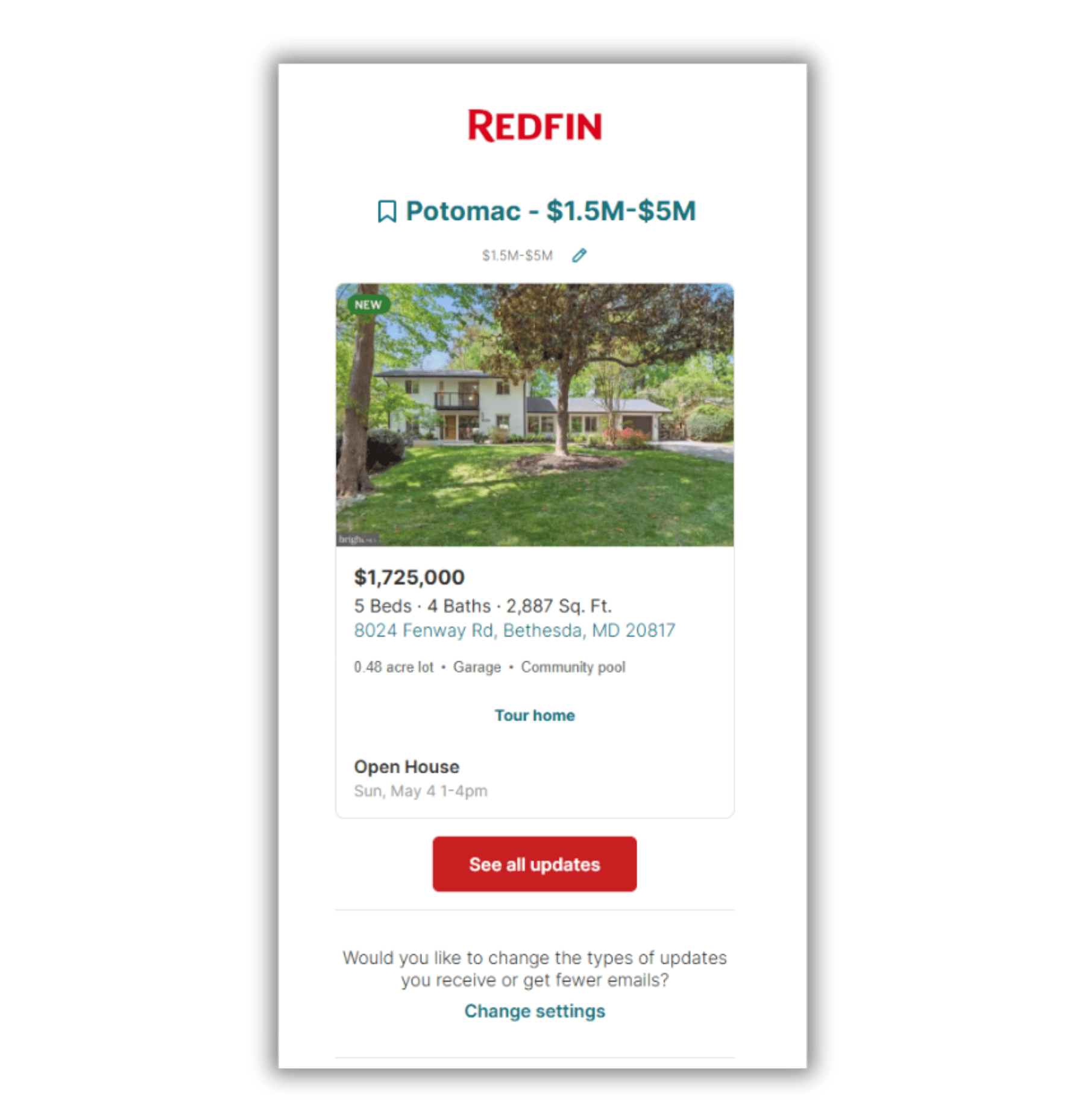
Subject line example: “Fresh on the market: Homes you’ll love”
What to include:
- 2–3 standout details, like square footage, updated finishes, or unique amenities, to grab interest.
- High-quality images to encourage click-throughs to the full listing.
- A “Schedule a Tour” CTA to entice buyers to take the next step.
Pro tips:
- Keep the message simple and visual.
- Ensure the listing price and location are clearly visible.
- Provide direct links to listings.
2. Featured Listing
Send regular emails that spotlight standout or unique properties to keep potential buyers engaged and excited about what’s on the market. The goal of this email is to draw attention with specificity and appeal.
Subject line example: “Featured property: Dream home with a lake view“
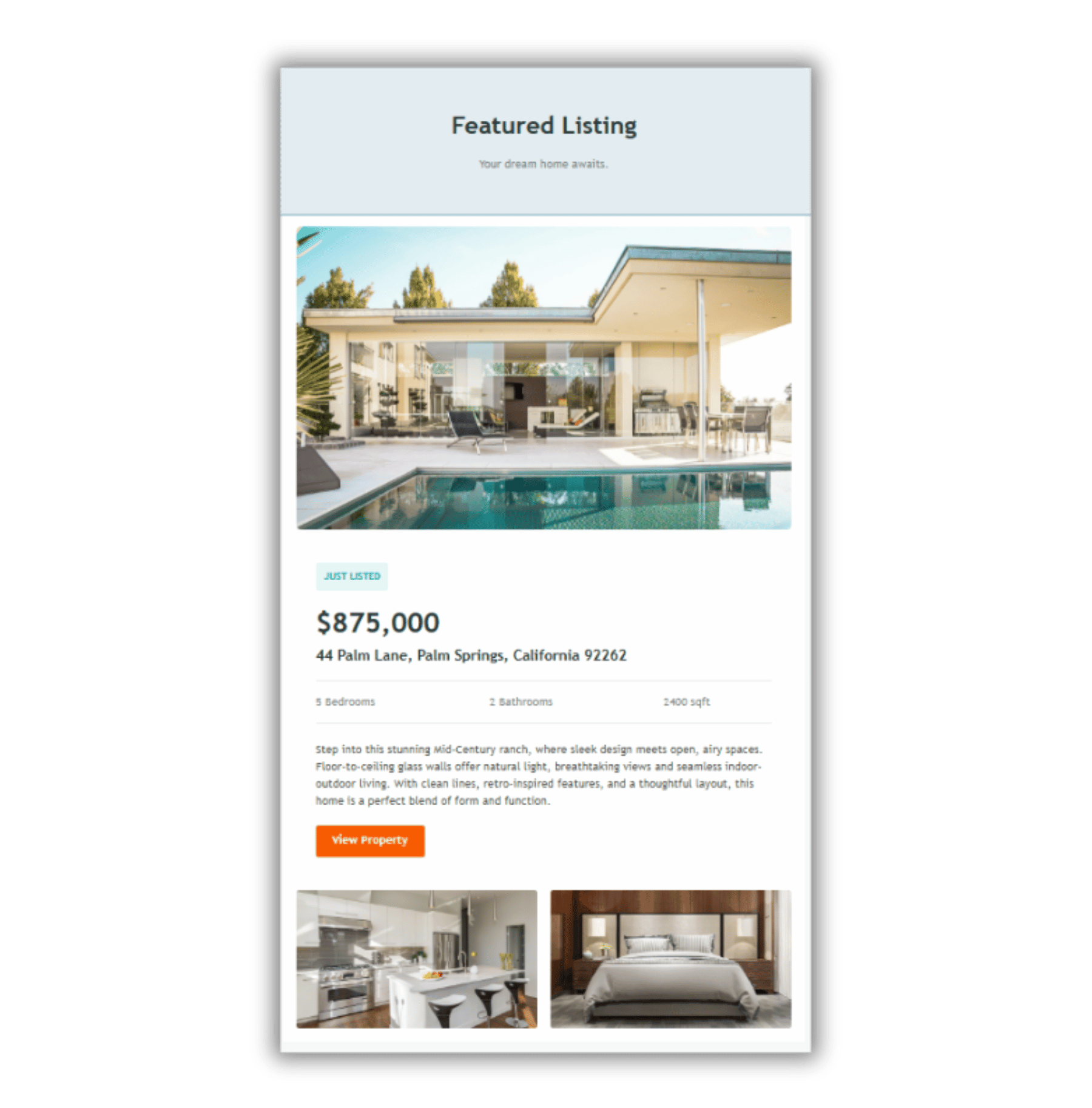
What to include:
- Highlight standout features like a gourmet kitchen, infinity pool, spectacular views, modern upgrades, or a great price point.
- Include links to video tours or 3D walkthroughs because homes with virtual tours sell for 9% more on average than those without one and close 31% quicker.
Pro tips:
- Rotate featured listings to hold readers’ interest.
- Clearly indicate what makes the property stand out.
- Use high-quality photos, compelling descriptions, and a direct link to the listing
3. Open House Invitations
Promote upcoming open houses to spark interest and encourage early sign-ups. Provide prospective buyers with all the necessary details to encourage attendance.
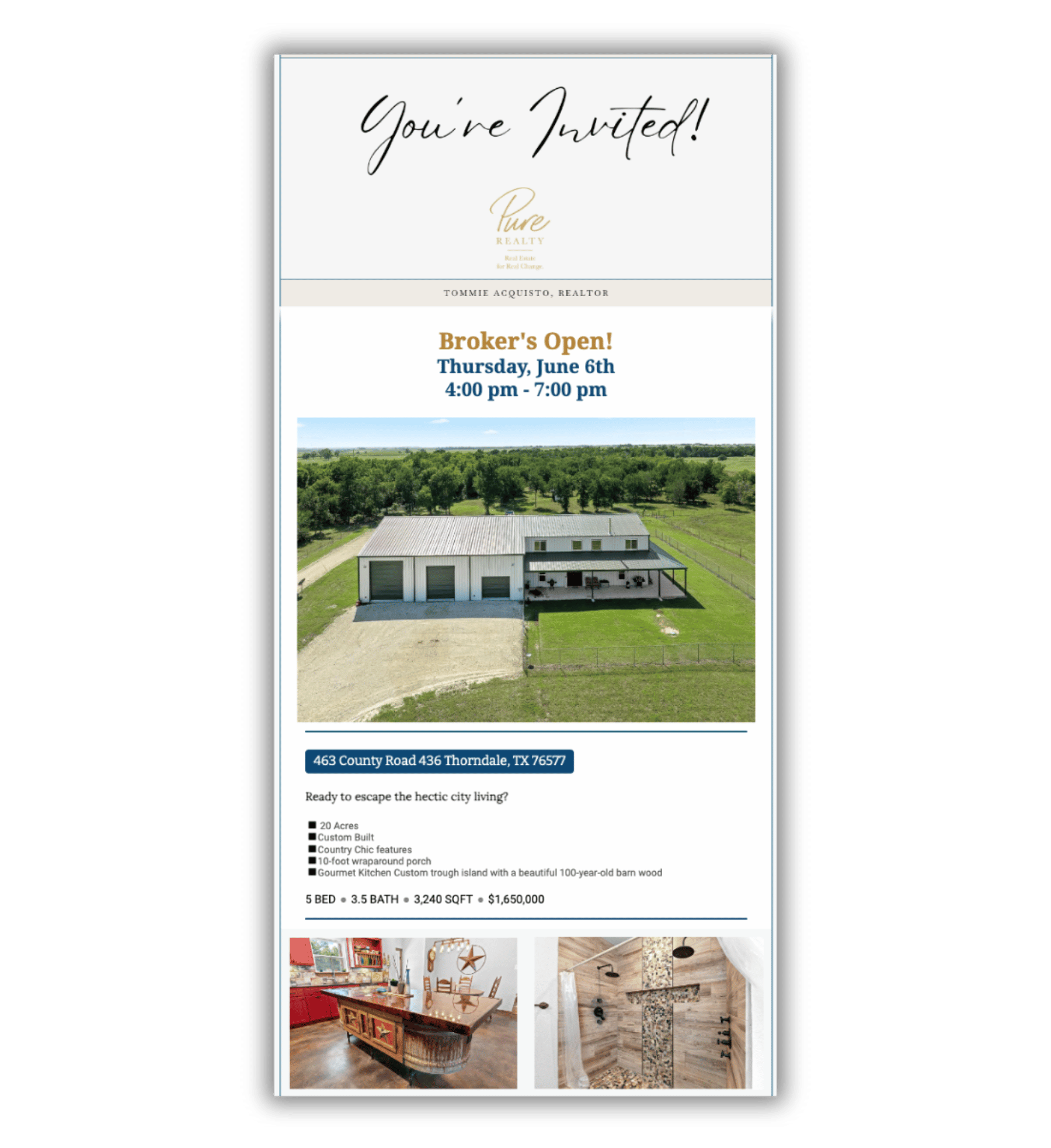
BigMailer customer: Pure Realty (TX)
Subject line example: “RSVP now: Open House this Saturday“
What to include:
- Standout details that the buyer must see for themselves, like a renovated kitchen or a backyard oasis.
- Add 2-3 photos and a link to a video or 3D walkthrough to build excitement.
- Create a sense of exclusivity or urgency with a CTA button, “Save your spot now!”
Pro tips:
- Ensure the event date, time, and location are displayed in a clear, easy-to-read font.
- Use inviting language and eye-catching images.
- Include specific details on how to RSVP, along with an RSVP button.
4. Open House Reminder
Send a reminder email to any recipients of an open house invitation a day or two before the event to boost attendance. This creates a sense of urgency and nudges attendance commitment.
Subject line example: “Don’t forget! Open house tomorrow“
What to include:
- Clearly list the date, time, and address, along with a clickable link to map directions or a calendar add.
- Reiterate what makes this home special.
Pro tips:
- Send 1-2 days in advance.
- Send an additional reminder that builds urgency to those who opened but did not RSVP.
5. Just Sold Near You to Potential Sellers
Share recent sales in the neighborhood to spark interest from nearby homeowners who may be considering selling. Highlighting quick sales or over-asking results can create a sense of urgency and demonstrate your expertise in the local market.
Subject line example: “See what your neighbor’s home just sold for“
What to include:
- Include the sale price and quick transaction details, like how competitive the offer was or whether it sold above asking, to demonstrate market momentum.
- Offer a free home valuation to help homeowners determine the potential value of their property.
- Send a comparison to neighborhood averages to show how the sale stacks up against recent comps.
Pro tips:
- Highlight short selling times.
- Use language to spark curiosity and motivate potential sellers (“Revealed”, “Insider look”, “Surprising”).
6. Price Drop Alert
Let buyers know when a property they’ve been eyeing becomes a better deal so they can schedule a tour or make an offer before someone else does.
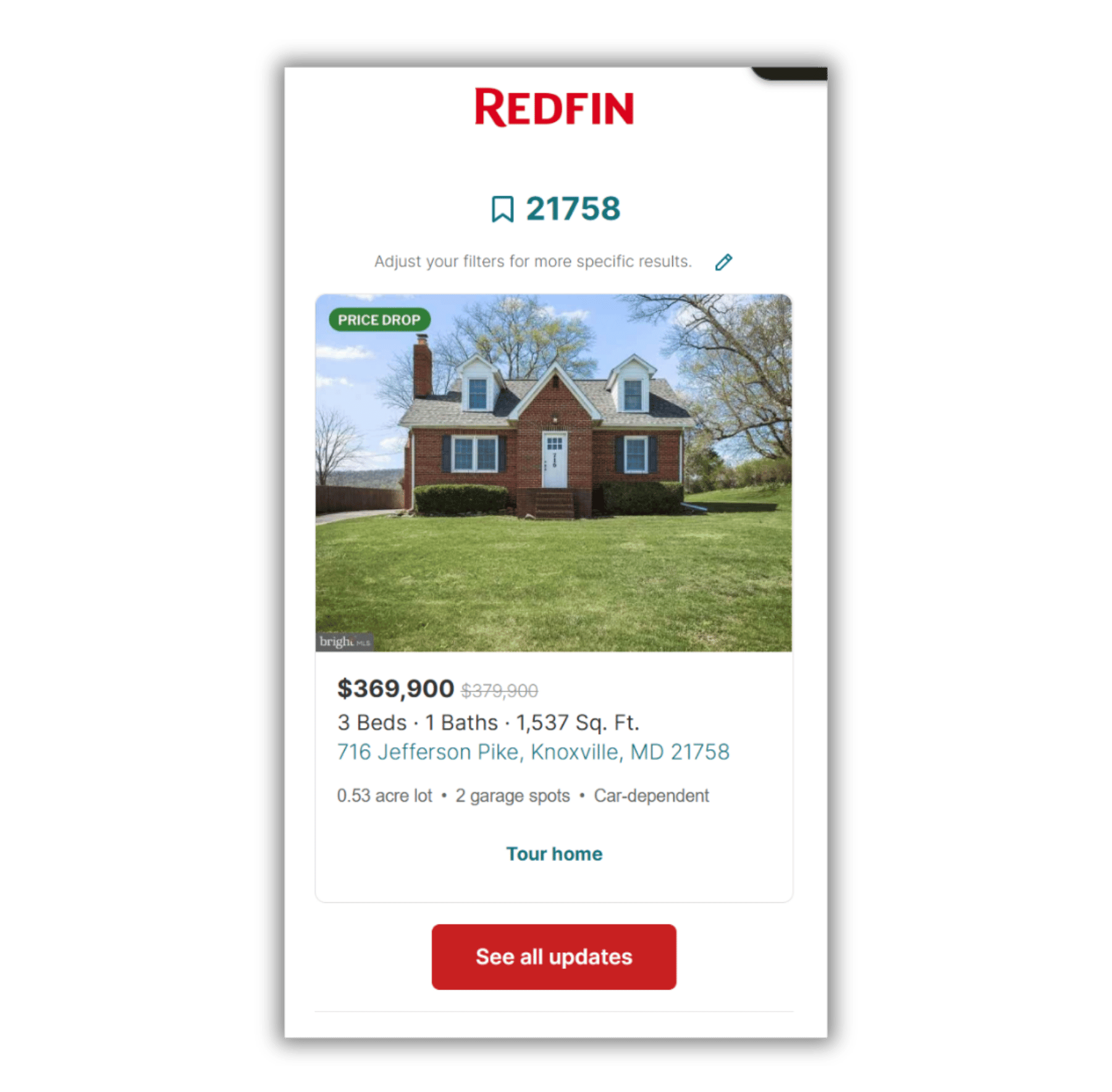
Subject line example: “Hot deals: Lower prices on homes in your area“
What to include:
- Use a graphic to display the original price alongside the new price, highlighting the savings and making the discount feel more substantial.
- Include a “Schedule a Showing” CTA to encourage fast action before someone else snags the deal.
Pro tips:
- Clearly state the new price and property details.
- Emphasize the duration the property has been on the market.
- Create FOMO by stressing that the reduced price won’t last, especially if there’s strong interest in the property.
- Highlight the reduced price, showcase key features, and include a bold call-to-action
- Link directly to the listing.
7. Welcome to a New Buyer or Seller
First impressions matter. So when a new home buyer enters your pipeline, roll out the virtual welcome mat. This email sets the tone for your working relationship and gives buyers the confidence that they’re in good hands from day one.
Subject line example: “Welcome! Your home-buying [or selling] journey starts here“
What to include:
- Share a “what to expect” timeline with a visual or bullet-point roadmap of the buying or selling process to reduce overwhelm and establish your expertise.
- Share links to neighborhood overviews, school rankings, or local hotspots to help buyers visualize their future lifestyle.
- Include a clear next-step CTA, whether it’s scheduling a consultation, filling out a wish list, or browsing current listings.
Pro tips:
- Automate our welcome email to send immediately after sign-up.
- Use warm, inviting language to put your new buyer or seller at ease.
8. Consultation Offer
Once a lead has shown interest — clicked on a listing, downloaded a guide, or browsed your site — it’s time to guide them toward a one-on-one consultation. This email helps convert curiosity into commitment by making the next step clear, easy, and low-pressure.
Subject line example: “Ready to buy [or sell]? Let’s schedule your consultation“
What to include:
- Clearly outline the benefits of consultation, like market insights, tailored property recommendations, or a personalized buying plan.
- Add a link to your booking calendar or a contact form.
- Set expectations by suggesting they bring a pre-approval letter, a list of must-haves, or questions about the process.
Pro tips:
- Highlight the ease of scheduling with flexible time slots or online booking.
- Mention that it’s free or no-obligation to reduce hesitation.
9. Follow-Up Post Consultation
Maintain momentum after your initial meeting with a follow-up email. This demonstrates to buyers or sellers that you’re attentive, professional, and ready to assist them in taking the next step, particularly when you include listings that match their specific preferences.
Subject line example: “Great meeting you — here’s what’s next“
What to include:
- Recap their must-haves, budget, and preferred neighborhoods to demonstrate that you’re listening and ready to deliver.
- Include 2–3 hand-picked properties that align with what they’re looking for to kick off the search and get them excited.
- Let them know what comes next, whether it’s scheduling showings, getting pre-approved, or reviewing listings together.
Pro tips:
- Send within 24-48 hours while the conversation is still fresh.
- Maintain a warm, helpful, and personal tone to foster a sense of rapport.
- This email is best sent manually because it requires personalization, although you can save time on writing the email by using a template.
10. Pre-Approval to Prospective Buyer
Help serious buyers get financially prepared by guiding them through the pre-approval process. This email positions you as a trusted advisor and creates an organic opportunity to refer a trusted local lender, while giving your clients a clearer picture of what they can afford.
Subject line example: “Get Pre-Approved & Shop Smarter”
What to include:
- Link to a mortgage calculator to help buyers estimate monthly payments and budget expectations.
- Refer a local mortgage professional, but be sure to mention that you may receive a referral fee — transparency builds credibility.
- Explain how pre-approval strengthens their offers and saves time during the buying process.
Pro tips:
- Include a brief checklist of the necessary documents for buyers to obtain pre-approval (e.g., ID, income information, credit history).
- Use a confident and encouraging tone, as this step can be intimidating for first-timers.
11. Cooling Buyer Follow-Up
When buyers go quiet, it doesn’t always mean they’re no longer interested — they may just need a nudge. A thoughtful follow-up can reignite the conversation, showcase what’s new on the market, and position you as their go-to expert when they’re ready to move forward.
Subject line example: “Still searching for your new home? We can help”
What to include:
- Send updated listings based on previous interests to show them the market has something new to offer.
- Include a helpful resource or market update to spark curiosity and demonstrate that you’re still working on their behalf.
- Invite them to reconnect for a short call or coffee to reassess their goals or timeline.
Pro tips:
- Personalize based on what they have previously engaged with (location, price range, or home type).
- Keep it casual and friendly, no hard sell, just helpful support.
- This email will also need to be written manually, but shave time off the process by using a template.
12. Market Insights Update
Regular market update emails are a great way to stay top-of-mind with buyers, sellers, and even past clients. Whether it’s a shift in interest rates or a trend in local home prices, these insights help clients make smarter decisions and position you as the go-to expert in your area.
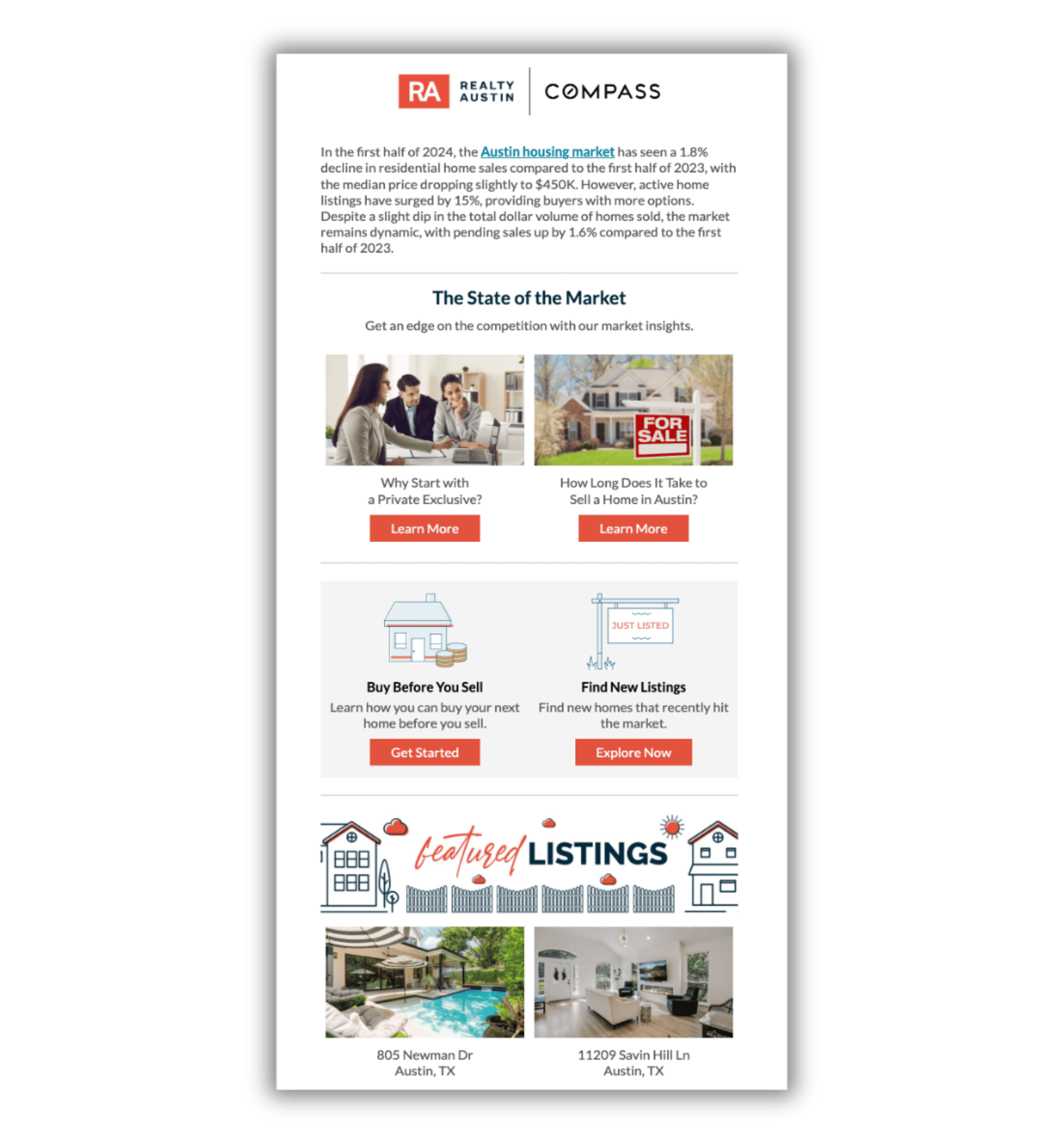
BigMailer customer: Realty Austin (TX)
Subject line example: “2 cities where buying beats renting”
What to include:
- Summarize key local and national trends by focusing on what’s changing and how it impacts buyers or sellers in your market.
- Share eye-catching stats, like average days on market, price increases, or inventory changes.
- Include a takeaway or what-it-means-for-you blurb by explaining how the news could affect buying or selling decisions right now.
Pro tips:
- Clearly state your sources (NAR, local MLS, Freddie Mac, etc.) to boost credibility.
- Skip the jargon, but rather, translate data into simple, actionable language your clients can understand and use.
13. Share Expert Guides (Buying/Selling)
Educate your audience and build long-term trust by sharing practical, easy-to-digest guides that walk clients through the buying or selling process. Content like this positions you as a knowledgeable advisor, not just someone trying to close a deal.
Subject line example: “Steps to buying your first home”
What to include:
- Create downloadable PDFs or interactive checklists that buyers and sellers can refer to throughout the entire process.
- Break down complex processes, like getting a mortgage or prepping a home for sale, into clear, actionable steps.
- Link to relevant blog posts or FAQs to keep readers engaged by offering deeper dives into topics that impact them.
Pro tips:
- Make sure the content is visually clean and easy to skim.
- Include a clear next step, such as “Book a call” or “Browse active listings.”
14. Client Stories and Testimonials
Let your happy clients do the talking. Sharing success stories builds trust, demonstrates your track record, and offers future clients a glimpse of what it’s like to work with you. These emails provide powerful social proof, which is important since 9 out of 10 people trust customer testimonials over business marketing claims.
Subject line example: “How we helped the Johnsons sell in under 7 days”
What to include:
- Highlight client journeys by sharing the challenge, solution, and outcome to create a compelling narrative future clients can relate to.
- Include direct quotes or video testimonials to add credibility and emotional impact.
Pro tips:
- Always get permission before sharing names, photos, or quotes.
- Keep it authentic — real stories resonate more than polished sales pitches.
15. Local’s Guide on Neighborhood Expertise
Buyers aren’t just shopping for homes, they’re choosing a lifestyle. Use this email to spotlight the neighborhoods you know best. Sharing insider tips, events, and hidden gems helps establish your expertise and builds a stronger emotional connection with your audience.
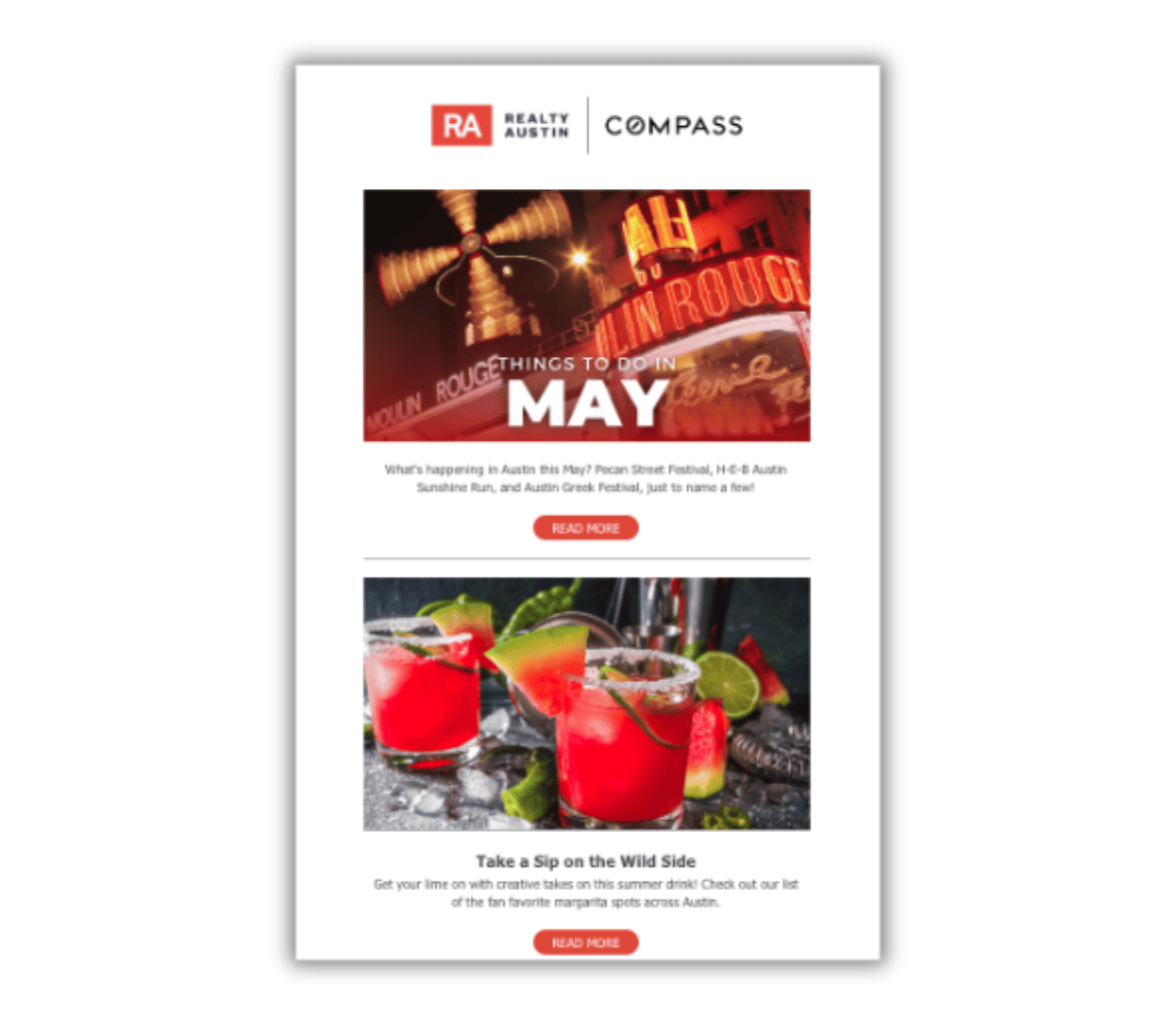
Subject line example: “Insider tips: Get to know your new neighborhood”
What to include:
- Include top spots and hidden gems like local parks, restaurants, coffee shops, or weekend activities that give buyers a sense of the community vibe.
- Share info on festivals, farmers markets, school updates, or development plans to show what’s happening nearby.
- Include links to neighborhood profiles or map guides, so buyers can explore areas virtually with curated online tools.
Pro tips:
- Write in a warm and authentic tone, as if sharing your favorite spots with a local friend.
- Update content regularly to keep it timely and relevant.
16. Post-Close Congrats and Thank You
Closing day is a major milestone. Celebrate it with a warm, thoughtful message that leaves a lasting impression. A well-timed congratulations email helps strengthen the relationship, shows genuine appreciation, and sets the stage for future referrals and repeat business.
Subject line example: “Congratulations on your new home!”
What to include:
- Write a warm, personal note that references their journey, including specific details, like their search length or a moment that stood out, to make it feel meaningful.
- Offer a small, thoughtful gift, like an e-gift card to a local business.
- Ask them to share their experience or refer a friend while the excitement is still fresh.
Pro tips:
- Send the email within 24–48 hours of the closing date.
- Personalize with the property address or photo.
17. Closing Checklist
Help your clients feel prepared and confident as they approach the final stages of their transaction. A pre-closing checklist ensures nothing falls through the cracks and gives buyers a sense of control during a hectic time.
Subject line example: “Your home closing checklist”
What to include:
- Clearly outline important documents to bring. Items like ID requirements, financial documents, and any necessary forms to be signed.
- Provide a timeline of final tasks, including key dates like the final walkthrough, utility transfers, and the closing appointment.
- Add quick tips for a smooth closing day. Remind them to bring a cashier’s check, who needs to be present to sign documents, and to plan for time off work if needed.
Pro tips:
- Send about one week before the scheduled closing.
- Keep the format clean and skimmable, using a checklist or bullet points.
18. Feedback or Survey Request
Once the dust settles after closing, reach out to gather feedback while the experience is still fresh. A quick survey shows clients you value their opinion, helping you refine your process and strengthen your service for future clients.
Subject line example: “Tell us about your experience & get a thank-you gift!”
What to include:
- State that you value their honest opinion.
- Request a Google review, direct them to a survey, or ask for feedback by replying to the email.
- Ask for a referral to fuel your future leads pipeline.
Pro tips:
- Send the request about a week after closing, when they’ve had time to settle in.
- Clearly state how long it will take (e.g., “Just a 2-minute survey”).
- Offer a small incentive for completion, a $5–$10 gift card or a home service discount, to boost participation.
- Keep the survey brief by limiting the number of questions to 3–5, focusing on key moments in the buying or selling journey.
- Include a personalized thank-you message.
19. Seasonal Home Maintenance Reminders
Help past clients protect their investment by sending timely home maintenance reminders throughout the year. It’s a smart, low-effort way to stay top-of-mind and continue delivering value long after the sale is done.
Subject line example: “Winter home maintenance tips“
What to include:
- Share a seasonal maintenance checklist with 5–10 tasks tailored to the season, like HVAC servicing, gutter cleaning, or sealing drafts.
- Recommend trusted local pros by offering your go-to vendors for services like chimney inspections, landscaping, or pest control.
- Link to a printable or interactive version, allowing homeowners to easily take action and save the list for future use.
Pro tips:
- Tailor emails to your local climate and typical seasonal needs.
- Send these quarterly or with the change of seasons to stay consistent and relevant.
7 Steps to Implement Real Estate Email Marketing
Great email marketing doesn’t just build awareness, it builds business. The right strategy can help you convert more leads, increase showings, and maintain a top-of-mind presence in a crowded market.
This section walks you through how to build a high-converting email marketing system — from choosing the right platform to designing emails that actually get read.
With the right tools and a solid plan, email can become one of your most efficient (and automated) closers.
1. Choose the Right Email Marketing Platform
Not all platforms are created equal, especially when it comes to real estate. Look for a solution that makes it easy to build relationships, automate campaigns, and track performance.
Here’s what to prioritize:
- Templates designed for real estate — Use email templates built for showcasing listings, promoting open houses, and highlighting agent services. This saves time and ensures your emails look polished without the need for design experience.

- CRM integration — Your email tool should sync with your CRM so you can segment leads by activity, stage, or location, and trigger campaigns automatically when someone signs up or books a showing.
- Audience segmentation — Not every buyer or seller is the same. Choose a platform that allows you to segment your audience by interest, price range, or neighborhood, so you can send targeted emails that actually get opened.
- Ease of use for non-technical teams — Many brokerages don’t have dedicated tech teams. Your platform should be intuitive enough for agents and marketers to use without requiring a steep learning curve or advanced coding skills.
- Affordability for small brokerages or solo agents — For smaller operations, cost matters. Look for pricing that scales with your business, without forcing you into expensive enterprise plans just to access automation features.
- Deliverability tools — Your emails can’t drive results if they land in spam. Look for platforms with built-in tools that improve deliverability, like email verification, advanced segmentation, and custom tracking domains.
- Helpful, human support — Especially for non-technical users, is a must. Choose a platform that offers live human assistance, not just a knowledge base, to help troubleshoot or guide you through setup.
- Lead capture forms — Growing your list is half the battle. Make sure your platform includes customizable forms that can be embedded on websites, landing pages, and open house sign-in sheets, so you never miss a new lead.
Still need an email marketing platform? BigMailer.io offers a cost-effective real estate email marketing platform that supports all of the above.
2. Grow Your List
A strong email list starts with intentional lead capture. Instead of buying lists (which can hurt deliverability and credibility), focus on organic growth strategies that attract engaged, high-quality contacts.
Ways to grow your list:
- Use valuation tools, buyer/seller guides, or newsletter CTAs on your website
- Promote free resources through social media and ads
- Add open house attendees and event sign-ups
- Host educational webinars or workshops for local buyers and sellers
Prioritize value-driven opt-ins to grow your list with people who genuinely want to hear from you and are more likely to convert.
3. Segment your list
List segmentation is key to sending relevant, high-performing emails. Start by organizing contacts into core groups, like buyers, sellers, agents, or internal teams.
Then go deeper. Segment by location, price range, or buying stage.
This allows you to promote listings only to buyers who can actually act on them, reducing inbox fatigue and boosting open rates. Better segmentation = better engagement, improved deliverability, and more qualified leads.
4. Plan Your Campaigns
Before launching a campaign, be intentional about your approach. Ask yourself: What’s the goal?
- Is it to drive a showing?
- Build trust?
- Educate a lead?
- Retain a client?
Start by creating templates for each of the emails listed above.
Set up automations and triggers to send timely, personalized emails, like Welcome emails. Then, map out and schedule your more general emails on a marketing calendar so you stay consistent and strategic over time.
Tailor emails for each segment, and design your cadence:
- Hot buyers? Try 2x/week.
- Long-term lead nurturing? Start with 3 times a month.
- Past clients? Seasonal check-ins or value-adds.
5. Write Your Copy
Your emails should sound like they’re written by a real person, not a bot. Keep it conversational, clear, and skimmable. Use social proof, sprinkle in curiosity (especially in subject lines), and avoid spam triggers like ALL CAPS or over-the-top sales language.
Tips for writing high-converting copy:
- Use subject lines and preview text to spark curiosity (e.g., “🏡 A hidden gem just hit the market…”)
- Break up text with short paragraphs or bullet points
- Always include a strong CTA that answers: What do I want the reader to do?
- “Book a showing”
- “Request a free home valuation”
- “Download our homebuyer checklist
- “Forward to a friend looking to buy”
6. Design and Customize Your Templates
Good design makes your emails easier to read and more likely to convert. Stick to clean layouts with large buttons, concise text blocks, and high-quality visuals.
Template best practices:
- Use alt text for images and test on mobile before sending
- Include your name, title, brokerage, and contact info
- Always add an unsubscribe link for compliance and trust
- Add a headshot to your email signature
Pro tip: Use merge tags and dynamic content to personalize subject lines and copy with first names, city/neighborhood, property type, or funnel stage (e.g. “Still thinking about selling in {City}?”).
7. Track, Test, and Optimize
Email marketing is never one-and-done. To improve performance and close more deals, you need to track what works and tweak what doesn’t.
Start by monitoring key metrics:
- Open rates (How are your subject lines performing?)
- Click-through rates (Is your content driving action?)
- Conversions (Are people scheduling showings, downloading guides, or replying?)
Then, test and refine.
- A/B test subject lines, visuals, and CTAs to see what resonates
- Try different send times or formats for different segments
- Use your data to guide future campaigns, not guesswork
The more you optimize, the better your results over time.
Ready to Close More Deals with Real Estate Email Marketing?
Of course you are. And now, you’re armed with actionable strategies and relevant email content to jump-start your real estate email marketing.
There’s no better time than now to begin.
BigMailer is here to help you build deep client relationships and sell more properties. Schedule a FREE demo today to see what BigMailer can do for your real estate email marketing.
Author: Jacob Statler
